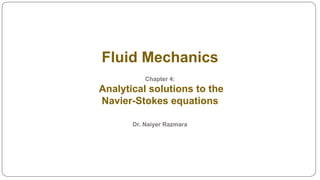Chapter 4 Couette-Poiseuille flow.pdf
- 1. Fluid Mechanics Chapter 4: Analytical solutions to the Navier-Stokes equations Dr. Naiyer Razmara
- 2. Some illustrative Examples A. Couette flow B. Poiseuille flow C. Flow in a circular pipe D. Flow near an Oscillating Plate Analytic solutions to the Navier-Stokes equations 1
- 3. Journal Bearing A. Flow between a Fixed and a Moving Plate: Plane Couette Flow 2
- 4. ŌĆó Two-dimensional ŌĆó Incompressible ŌĆó Plane ŌĆó Viscous flow ŌĆó Between parallel plates a distance 2h apart ŌĆó Assume that the plates are very wide and very long, so that the flow is essentially axial ŌĆó The upper plate moves at velocity V but there is no pressure gradient ŌĆó Neglect gravity effects The continuity equation A. Flow between a Fixed and a Moving Plate: Plane Couette Flow 3
- 5. ŌĆó Thus there is a single nonzero axial-velocity component which varies only across the channel. ŌĆó The flow is said to be fully developed (far downstream of the entrance). ŌĆó The Navier-Stokes momentum equation for two-dimensional (x, y) flow: The no-slip condition A. Flow between a Fixed and a Moving Plate: Plane Couette Flow 4
- 6. The solution for the flow between plates with a moving upper wall, is: This is Couette flow due to a moving wall: a linear velocity profile with no-slip at each wall, as anticipated. A. Flow between a Fixed and a Moving Plate: Plane Couette Flow 5
- 7. B. Flow due to Pressure Gradient between Two Fixed Plate: Plane Poiseuille Flow (Channel Flow) Assumptions: ŌĆó Both plates are fixed. ŌĆó The pressure varies in the x direction. ŌĆó The gravity is neglected. ŌĆó The x-momentum equation changes only because the pressure is variable: ŌĆó Poiseuille flows are driven by pumps that forces the fluid to flow by modifying the pressure. ŌĆó Fluids flow naturally from regions of high pressure to regions of low pressure. ŌĆó Typical examples are cylindrical pipe flow and other duct flows. ŌĆó Figure below illustrates a fully developed plane channel flow. ŌĆó Fully developed Poiseuille flows exists only far from the entrances and exits of the ducts, where the flow is aligned parallel to the duct walls. 6
- 8. The y- and z-momentum equations lead to: Thus the pressure gradient is the total and only gradient: The solution is accomplished by double integration: The constants are found from the no-slip condition at each wall: B. Flow due to Pressure Gradient between Two Fixed Plate: Plane Poiseuille Flow (Channel Flow) 7
- 9. Thus the solution to the flow in a channel due to pressure gradient, is: The flow forms a Poiseuille parabola of constant negative curvature. The maximum velocity occurs at the centerline: B. Flow due to Pressure Gradient between Two Fixed Plate: Plane Poiseuille Flow (Channel Flow) 8
- 10. If we assume the flow is in the x-direction, then the velocity vector is u(y, z, t) = (u(y, z, t), 0, 0) and Navier- Stokes equations can be simplified to C. Flow in circular pipe For a steady cylindrical pipe flow with radius r0 the solution is found simply by integrating twice and applying boundary conditions: 9
- 11. C. Flow in circular pipe 10
- 12. D. Flow near an Oscillating Plate Consider that special case of a viscous fluid near a wall that is set suddenly in motion as shown in Figure 1. The unsteady Navier-Stokes reduces to: 11
- 13. D. Flow near an Oscillating Plate 12
- 14. Substituting the last two equations into the reduced Navier-stokes equation, it follows that D. Flow near an Oscillating Plate 13













